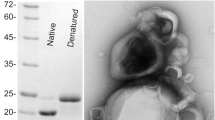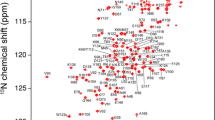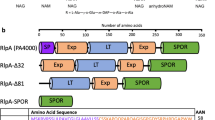Abstract
Bacteria surround their cytoplasmic membrane with the essential heteropolymer peptidoglycan (PG), which is made of glycan chains cross-linked by short peptides, to maintain osmotic stability and cell shape. PG is assembled from lipid II precursor by glycosyltransferase and transpeptidase reactions catalyzed by PG synthases, which are anchored to the cytoplasmic membrane and are controlled from inside the cell by cytoskeletal elements. Recently, two lipoproteins, LpoA and LpoB, were shown to be required in Escherichia coli for activating the main peptidoglycan synthases, Penicillin-Binding Proteins 1A and 1B, from the outer membrane. Here we present the backbone and side-chain assignment of the 1H, 13C and 15N resonances of LpoB from E. coli. We also provide evidence for a two-domain organization of LpoB and a largely disordered, 64 amino acid-long N-terminal domain.
Similar content being viewed by others
Avoid common mistakes on your manuscript.
Biological context
Peptidoglycan (PG) is a bacterial cell wall polymer made of glycan chains cross-linked by peptide stems. It forms a net-like, elastic layer (‘sacculus’) completely surrounding the cytoplasmic membrane to maintain cell shape and to prevent bursting of the cell due to its turgor. Gram-negative bacteria, such as Escherichia coli, have in their periplasm a mainly single-layered sacculus that is tightly connected to the outer membrane via interactions with abundant outer membrane proteins, such as Braun’s lipoprotein (Lpp), OmpA and Pal.
During the cell cycle, the PG sacculus grows by the incorporation of new material produced by glycosyltransferases (GTases), which polymerize lipid II precursor into glycan chains, and d,d-transpeptidases (TPases), which cross-link the peptide stems (Typas et al. 2012). Sacculus growth is accompanied by the release of a significant amount of old PG (~40 % per generation) by PG hydrolases. PG synthases and hydrolases presumably form dynamic, inner membrane-anchored multi-enzyme complexes. These are controlled from inside the cell by cytoskeletal elements, including the actin-like MreB and the tubulin-like FtsZ. Escherichia coli carries three bifunctional PG synthases with GTase and TPase activities (PBP1A, PBP1B and PBP1C), one monofunctional GTase (MgtA) and two monofunctional TPases (PBP2 and PBP3). PBP2 is essential for cell elongation and interacts with PBP1A (Banzhaf et al. 2012). PBP3 is essential for cell division and interacts with PBP1B (Bertsche et al. 2006). Escherichia coli requires at least one of the main bifunctional enzymes, PBP1A and PBP1B, for survival.
Recent work showed that in E. coli, and presumably in other Gram-negative bacteria, PG synthesis is regulated by outer-membrane anchored lipoproteins (Paradis-Bleau et al. 2010; Typas et al. 2010). LpoA and LpoB interact in vitro and in the cell with their cognate PG synthases, PBP1A and PBP1B, respectively, presumably forming trans-envelope complexes through the periplasm. The synthases require their cognate Lpo protein for function and, hence, the cell cannot survive without LpoA and LpoB. In vitro, LpoA (YraM) stimulates the TPase activity of PBP1A, and LpoB (YcfM) stimulates both, the GTase and TPase activities of PBP1B (Paradis-Bleau et al. 2010; Typas et al. 2010).
The X-ray structure of PBP1B revealed the presence of a small, non-catalytic domain, called UB2H, which resides between the GTase and TPase domains and is unique to this synthase (Sung et al. 2009). Based mostly on genetic evidence, UB2H was suggested to be the docking site for LpoB (Typas et al. 2010). However, there are currently no structural data at atomic resolution on LpoB, and the interface of PBP1B and LpoB is not known. As a first step towards the elucidation of the mechanism by which LpoB stimulates PBP1B, we report here the essentially complete backbone and side-chain 1H, 13C, 15N resonance assignment of LpoB from E. coli. In our LpoB construct the N-terminal outer-membrane lipid anchor of the native protein [diacylglycerol-(acyl)cysteine] is replaced by four extra amino acid residues (GSHM) that were left upon cleavage of an oligohistidine-tag introduced for purification purposes. The assignment of chemical shifts and a first structural characterization provide evidence of a disordered N-terminal region from residues 1 to 64 and a well-structured C-terminal domain from residues 65 to 197.
Sample preparation
Soluble recombinant 13C, 15N-labeled LpoB, in which the N-terminal membrane anchoring signal peptide was replaced by an oligohistidine tag, [MGSSH6SSGLVPRGSHM-LpoB(V21-Q213)] was produced from an E. coli BL21(DE3) strain harboring the pET28LpoB plasmid (Typas et al. 2010). Cells were grown overnight at 37 °C in 100 mL of M9 minimal medium containing 3 g/L [13C]-d-glucose, 1 g/L [15N]-NH4Cl (Cambridge Isotope Laboratories, Tewksbury MA, USA), 50 µg/mL kanamycin and 2 mM thiamine from a preculture in rich medium. The cells were harvested by centrifugation, resuspended in 1 L of fresh M9 growth medium and grown at 30 °C to an OD578 of 0.6. IPTG (1 mM) was added and the cells were incubated further for 3 h at 30 °C for LpoB overproduction. Cells were harvested by centrifugation (10,000×g, 15 min, 4 °C) and the pellet was resuspended in 40 mL of 25 mM Tris/HCl, 10 mM MgCl2, 500 mM NaCl, 20 mM imidazole, 10 % glycerol, pH 7.5 (buffer A). A small amount of DNase, protease inhibitor cocktail (Sigma, 1/1,000 dilution) and 100 μM of phenylmethylsulfonylfluoride (PMSF) were added before cells were disrupted by sonication (Branson Digital Sonifier). The insoluble material was removed by ultracentrifugation (130,000×g, 1 h, 4 °C) and the supernatant was loaded onto a 5 mL HisTrap HP column (GE healthcare), attached to an ÄKTA Prime+ (GE Healthcare). The column was washed with 4 volumes of buffer A before elution of bound proteins with 25 mM Tris/HCl, 10 mM MgCl2, 500 mM NaCl, 400 mM imidazole, 10 % glycerol, pH 7.5 (buffer B) at a flow rate of 1 mL/min. To remove the oligohistidine tag, 50 U/mL of restriction grade Thrombin (Novagen) was added to LpoB and left to react for 18 h at 4 °C. The mixture was then dialyzed against 2 L of 25 mM Tris/HCl, 100 mM NaCl, 10 % glycerol, pH 8.3, before it was applied to a 5 mL HiTrap Q HP column (GE healthcare) attached to an ÄKTA Prime+ (GE Healthcare). LpoB was collected in the flow-through with a buffer flow-rate of 0.5 mL/min. The LpoB sample was concentrated to 4–5 mL using a VivaSpin-6 column (MW cut-off 5,000 Da) and loaded onto a Superdex200 HiLoad 16/600 column for size exclusion chromatography. LpoB eluted after ~85 min in 25 mM HEPES/NaOH, 1 M NaCl, 10 % glycerol, pH 7.5 at a flow rate of 1 mL/min. LpoB was finally dialyzed against 100 mM sodium acetate buffer at pH 4.5 and concentrated using a VivaSpin-6 spin column (Sartorius).
NMR spectroscopy
All NMR data were collected at 308 K on a 0.8 mM sample of 13C,15N-labeled LpoB in 100 mM sodium acetate buffer, pH 4.5 containing 10 % D2O. All of the NMR experiments for backbone and side-chain assignment were performed on Agilent spectrometers operating at 600 or 800 MHz 1H NMR frequencies with the exception of an aliphatic 13C-NOESY-HSQC, which was recorded on the French national platform on a 950 MHz Bruker US2 spectrometer. All of the spectrometers were equipped with a cryogenic triple 1H, 13C, 15N resonance probe. Backbone chemical shifts were assigned in a sequential manner from the following experiments: 2D [1H,15N]-HSQC, 2D Pro-HN(COCAN) and Pro-iHN(CAN) (Solyom et al. 2013), 3D (H)N(COCA)NH, 3D BEST-HNCACB and BEST-HN(CO)CACB (Lescop et al. 2010), 3D HNCO and 3D HN(CA)CO. Side-chains were assigned using 2D aliphatic and aromatic [1H,13C]-CT-HSQCs, a 2D methyl-selective [1H,13C]-CT-HSQC (Van Melckebeke et al. 2004), a 2D [1H,15N]-HMQC experiment optimized for the detection of 2JNH couplings in imidazole rings (Pelton et al. 1993), a 3D H(C)CH-TOCSY, a 3D (H)C(CCO)NH, a 3D H(CCCO)NH, and a 3D 15N-NOESY-HSQC with 150 ms mixing time, as well as 3D aliphatic, aromatic and methyl-13C-NOESY-HSQC (Van Melckebeke et al. 2004) experiments with mixing times of 120, 130, and 160 ms, respectively. NMR data were processed using NMRPipe (Delaglio et al. 1995) and analyzed using the CcpNmr Analysis 2.2 software (Vranken et al. 2005). Dihedral angles and secondary structure predictions were obtained using the program TALOS+ (Shen et al. 2009) and the secondary structure chart tool of CcpNmr, respectively. The latter calculates the difference between observed and random coil Cα, Cβ, CO and Hα chemical shifts taking into account sequence-dependent effects according to a protocol described (Schwarzinger et al. 2001).
Extent of assignments and data deposition
Figure 1 shows an assigned 2D 13C-decoupled [1H, 15N]-HSQC spectrum of 13C, 15N-labeled LpoB at pH 4.5 and 308 K. In addition to well-dispersed signals, the center of the spectrum is buried with very intense and sharp resonances, some of which remain unassigned. Analysis of the sequential backbone experiments afforded the identification and sequence specific assignments for 166 out of the 177 expected backbone 1H and 15N amide resonances (93.2 %) (not counting the 19 Pro residues and the N-terminal amino acid). Starting from the assigned amide resonances, we were able to complete the assignment of 90.3, 90.4, and 90.0 % of CO, Cα, and Cβ resonances, respectively, over the whole protein construct. Missing assignments affect exclusively the N-terminal proline-rich region (27 %) defined by the first 60 residues: residues G1 to S3, P10 to A11, P18 to Q22, P26 to P31, P40 to Q42, and P54 to A56. In this protein region, the specific assignment procedure was hindered by the extensive redundancy of short sequences, such as the three PXXP sequences with X = Gln or Glu. Despite these unassigned residues at the N-terminus, 87.4, 83.9, 79.3, and 79.1 % of the Hα, Hβ, aromatic and other aliphatic side-chain protons, respectively, could be assigned over the complete protein construct. Side-chain 13C assignments (from Cγ on) were completed to 70.6 and 79.3 % for aliphatic and non-quaternary aromatic carbons, respectively. Unusual chemical shifts have been observed for a restricted set of nuclei, i.e. Y62 Hβs, M75 Hα and Hβ1, A105 Hα and Hβs and T183 N. These nuclei are upfield shifted compared with the expected values, suggesting that they are stacked onto aromatic rings and thus experience ring current shifts.
Fully assigned 2D [1H,15N]-HSQC spectrum of a 0.8 mM sample of 13C,15N-labeled LpoB in 100 mM sodium acetate buffer, pH 4.5, containing 10 % D2O at 308 K. Each backbone amide resonance is labeled with the amino acid type (one-letter code) and position in the sequence. Amino groups from tryptophan (Hε1-Nε1) and arginine (Hε-Nε) side chains are labeled with “sc”. Assigned amide groups from glutamine and asparagine side chains are outlined with horizontal dotted lines and labeled with “sc”. The position of the resonance of amino acids for which the signal intensity is below the threshold contour level is indicated with a cross (×). The sensitivity of the three experiments was sufficient in 3D experiments to assign the corresponding residues with standard procedures together with the other residues
The secondary structure of LpoB was predicted using the Cα and CO chemical shift deviations from random coil values (Schwarzinger et al. 2001) and the empirical determination of phi/psi by TALOS+ from measured backbone chemical shift data (Shen et al. 2009) (Fig. 2). In agreement with the presence of 27 % Pro residues, the G1 to W64 segment is largely unstructured with Cα and CO chemical shifts close to random coil values and IUPred scores larger than 0.55. This unstructured N-terminal region was predicted by IUPred (http://iupred.enzim.hu/) based on the primary sequence (Fig. 2). IUPred also predicted an unfolded region from N97 to L109 which, however, is limited to residues N97 to N101, as TALOS+ and Cα/CO chemical shift deviations indicate an α-helical structure from A102. The analysis of chemical shift data thus suggests that LpoB contains a N-terminal disordered tail and a globular domain consisting of 3 α-helices and 5 β-strands. Based on this assignment we aim to determine the 3D structure of LpoB at atomic resolution with the detailed structural organization of the globular domain, to gain insights into the activation mechanism of PBP1B.
Amino acid sequence and secondary structure of LpoB. The N-terminal GSHM sequence (red) remained after cleavage of the oligohistidine tag by thrombin. The secondary structure elements, 4 α-helices and 5 β-strands shown below the sequence, were predicted using TALOS+ according to the experimental backbone chemical shifts. Chemical shift deviations from random coil values (in ppm) were calculated for Cα and CO for each residue within the CcpNmr Analysis 2.2 software as published (Schwarzinger et al. 2001). These Cα and CO values are shown as black and blue histograms, respectively. IUPred scores were calculated from the sequence to predict highly disordered regions (IUPred scores for the corresponding residues higher than 0.55, i.e. above the dotted line in the graph). The absence of Cα and CO significant chemical shift deviations and the high IUPred scores in the first 64 residues consistently suggest a highly disordered N-terminal region
All 1H, 13C and 15N chemical shifts and their assignment have been deposited in the BioMagResBank (http://www.bmrb.wisc.edu) under the accession number 19681.
References
Banzhaf M, van den Berg van Saparoea B, Terrak M, Fraipont C, Egan A, Philippe J, Zapun A, Breukink E, Nguyen-Distèche M, den Blaauwen T et al (2012) Cooperativity of peptidoglycan synthases active in bacterial cell elongation. Mol Microbiol 85:179–194
Bertsche U, Kast T, Wolf B, Fraipont C, Aarsman MEG, Kannenberg K, von Rechenberg M, Nguyen-Distèche M, den Blaauwen T, Holtje J-V et al (2006) Interaction between two murein (peptidoglycan) synthases, PBP3 and PBP1B, in Escherichia coli. Mol Microbiol 61:675–690
Delaglio F, Grzesiek S, Vuister GW, Zhu G, Pfeifer J, Bax A (1995) NMRPipe: a multidimensional spectral processing system based on UNIX pipes. J Biomol NMR 6:277–293
Lescop E, Kern T, Brutscher B (2010) Guidelines for the use of band-selective radiofrequency pulses in hetero-nuclear NMR: example of longitudinal-relaxation-enhanced BEST-type 1H–15N correlation experiments. J Magn Reson 203:190–198
Paradis-Bleau C, Markovski M, Uehara T, Lupoli TJ, Walker S, Kahne DE, Bernhardt TG (2010) Lipoprotein cofactors located in the outer membrane activate bacterial cell wall polymerases. Cell 143:1110–1120
Pelton JG, Torchia DA, Meadow ND, Roseman S (1993) Tautomeric states of the active-site histidines of phosphorylated and unphosphorylated III Glc, a signal-transducing protein from Escherichia coli, using two-dimensional heteronuclear NMR techniques. Protein Sci 2:543–558
Schwarzinger S, Kroon GJA, Foss TR, Chung J, Wright PE, Dyson HJ (2001) Sequence-dependent correction of random coil NMR chemical shifts. J Am Chem Soc 123:2970–2978
Shen Y, Delaglio F, Cornilescu G, Bax A (2009) TALOS+: a hybrid method for predicting protein backbone torsion angles from NMR chemical shifts. J Biomol NMR 44:213–223
Solyom Z, Schwarten M, Geist L, Konrat R, Willbold D, Brutscher B (2013) BEST-TROSY experiments for time-efficient sequential resonance assignment of large disordered proteins. J Biomol NMR 55:311–321
Sung M-T, Lai Y-T, Huang C-Y, Chou L-Y, Shih H-W, Cheng W-C, Wong C-H, Ma C (2009) Crystal structure of the membrane-bound bifunctional transglycosylase PBP1b from Escherichia coli. Proc Natl Acad Sci USA 106:8824–8829
Typas A, Banzhaf M, van den Berg van Saparoea B, Verheul J, Biboy J, Nichols RJ, Zietek M, Beilharz K, Kannenberg K, von Rechenberg M et al (2010) Regulation of peptidoglycan synthesis by outer-membrane proteins. Cell 143:1097–1109
Typas A, Banzhaf M, Gross CA, Vollmer W (2012) From the regulation of peptidoglycan synthesis to bacterial growth and morphology. Nat Rev Micro 10:123–136
Van Melckebeke H, Simorre J-P, Brutscher B (2004) Amino acid-type edited NMR experiments for methyl–methyl distance measurement in 13C-labeled proteins. J Am Chem Soc 126:9584–9591
Vranken WF, Boucher W, Stevens TJ, Fogh RH, Pajon A, Llinas M, Ulrich EL, Markley JL, Ionides J, Laue ED (2005) The CCPN data model for NMR spectroscopy: development of a software pipeline. Proteins 59:687–696
Acknowledgments
Financial support by the French TGIR-RMN-THC FR3050 CNRS for conducting the research on the 950 MHz spectrometer (ICSN, Gif-sur-Yvette) and on the 800 MHz spectrometer (IBS, Grenoble) is gratefully acknowledged. This work was further supported by a PhD fellowship to NLJ (Contrat de Formation par la Recherche) from the Commissariat à l’Energie Atomique et aux Energies Alternatives. WV was supported by the European Commission (DIVINOCELL) and the BBSRC (BB/I020012/1).
Conflict of interest
The authors declare that they have no conflict of interest.
Author information
Authors and Affiliations
Corresponding author
Rights and permissions
Open Access This article is licensed under a Creative Commons Attribution 4.0 International License, which permits use, sharing, adaptation, distribution and reproduction in any medium or format, as long as you give appropriate credit to the original author(s) and the source, provide a link to the Creative Commons licence, and indicate if changes were made.
The images or other third party material in this article are included in the article’s Creative Commons licence, unless indicated otherwise in a credit line to the material. If material is not included in the article’s Creative Commons licence and your intended use is not permitted by statutory regulation or exceeds the permitted use, you will need to obtain permission directly from the copyright holder.
To view a copy of this licence, visit https://creativecommons.org/licenses/by/4.0/.
About this article
Cite this article
Jean, N.L., Bougault, C.M., Egan, A.J.F. et al. Solution NMR assignment of LpoB, an outer-membrane anchored Penicillin-Binding Protein activator from Escherichia coli . Biomol NMR Assign 9, 123–127 (2015). https://doi.org/10.1007/s12104-014-9557-z
Received:
Accepted:
Published:
Issue Date:
DOI: https://doi.org/10.1007/s12104-014-9557-z






